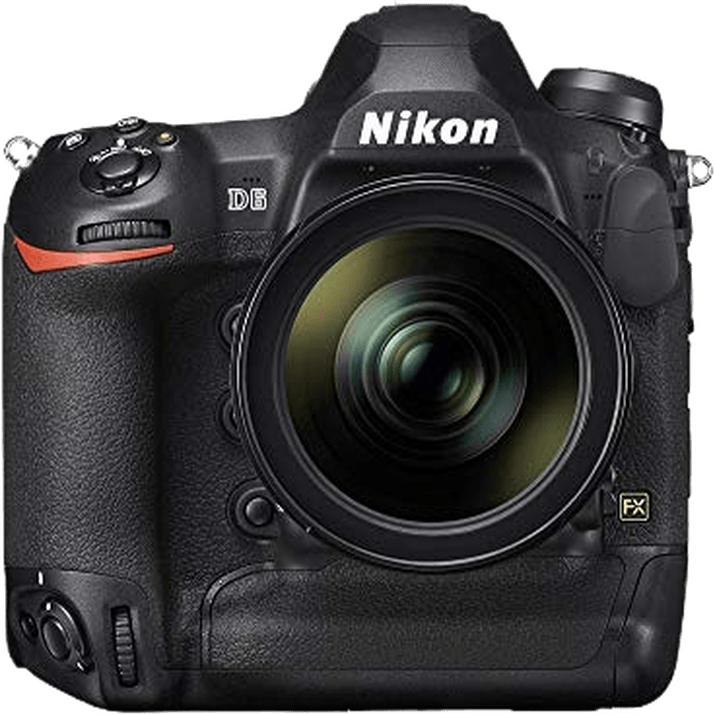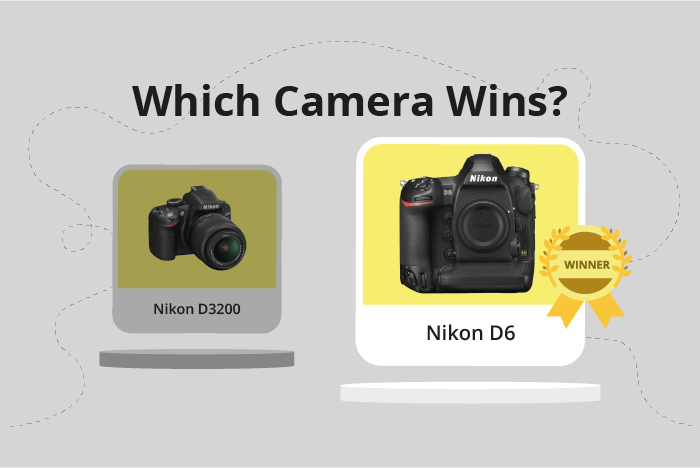Nikon D3200 vs D6 Comparison
Nikon D3200

Nikon D6

The Nikon D6 outperforms the Nikon D3200 with a score of 80/100 compared to 54/100. Both cameras are DSLRs released by Nikon, with the D3200 in 2012 and the D6 in 2020. They share similarities in their camera type and brand. However, the D6 is superior due to its higher score, making it a better camera overall.
The D6 boasts a more recent release year and a higher launch price of $6500, compared to the D3200’s $699. The increased price reflects the improved technology and features in the D6. However, the D3200 has its advantages, as it is smaller and lighter, measuring 125 x 96 x 77mm and weighing 505g, while the D6 measures 160 x 163 x 92mm and weighs 1450g.
Taking these factors into account, the Nikon D6 is a better camera for those seeking advanced features and performance, while the Nikon D3200 is a more budget-friendly and portable option.
Nikon D3200 vs D6 Overview and Optics
The Nikon D6 outperforms the Nikon D3200 in optics with a score of 75/100 compared to the D3200’s 63/100. Both cameras share certain specifications, including the CMOS sensor type, Nikon F lens mount, and lack of image stabilization.
The D6 excels in various aspects, such as its 20.8 megapixels, Expeed 6 processor, and full-frame sensor size. Its impressive shooting speed of 14 frames per second (fps) surpasses the D3200’s 4 fps, allowing for better capture of fast-moving subjects. The D6 also boasts a higher DXOMARK score of 97 for its sensor, indicating superior image quality and low-light performance.
On the other hand, the D3200 has a higher megapixel count of 24.2, which may provide slightly more detailed images. However, this advantage is offset by its lower overall performance in other areas. Its Expeed 3 processor and APS-C sensor size do not match the capabilities of the D6. The D3200’s lower DXOMARK score of 81 reflects its inferior image quality compared to the D6.
Despite the D3200’s higher megapixel count, the Nikon D6 is the clear winner in optics due to its superior shooting speed, sensor size, and image quality. The D6’s advanced processor and higher DXOMARK score further solidify its position as the better camera in this comparison. While the D3200 may offer slightly more detailed images, its overall performance does not match that of the D6.
Nikon D3200 vs D6 Video Performance
The Nikon D6 outperforms the Nikon D3200 in video capabilities, boasting a video score of 83/100 compared to the D3200’s 43/100. Both cameras share some specifications, such as offering Full HD resolution and the ability to capture 1920 x 1080 video dimensions. However, the similarities end there, as the D6 excels in various aspects.
The Nikon D6 surpasses the D3200 with its 4K video resolution and maximum video dimensions of 3840 x 2160, resulting in higher quality videos. Additionally, the D6 offers a higher maximum video frame rate of 60fps, compared to the D3200’s 30fps, providing smoother motion and better slow-motion capabilities. The D6 also comes with built-in time-lapse functionality, a feature absent in the D3200.
On the other hand, the Nikon D3200 does not offer any significant advantages over the D6 in terms of video capabilities. The D3200’s lower frame rate and lack of time-lapse functionality limit its potential compared to the D6.
Considering each camera’s video specifications, the Nikon D6 is the clear winner in this comparison. Its 4K resolution, higher frame rate, and time-lapse functionality make it a superior choice for videographers. The D3200, while still offering Full HD resolution, falls short in providing advanced video features found in the D6.
Nikon D3200 vs D6 Features and Benefits
The Nikon D6 emerges as the clear winner in the features comparison, scoring 87/100, while the Nikon D3200 lags behind with a score of 41/100. Both cameras share some common specifications, such as a screen size of 3 inches for the D3200 and 3.2 inches for the D6, but the similarities end there.
The D6 outperforms the D3200 in several aspects. It boasts a higher screen resolution of 2,359,000 dots compared to the D3200’s 921,000 dots. The D6 also features a touchscreen, making it more user-friendly and versatile. In terms of connectivity, the D6 is equipped with GPS, WIFI, and Bluetooth capabilities, which the D3200 lacks.
The D3200 has no particular advantages over the D6 in the features category. However, its lower score does not necessarily imply that it is a poor camera. It may still produce quality images and offer a satisfactory user experience for those who do not require the advanced features of the D6.
When comparing the features of the Nikon D3200 and the Nikon D6, the D6 is the superior camera due to its higher screen resolution, touchscreen, and connectivity options. The D3200, while scoring lower, may still be a viable option for those who do not prioritize these advanced features. Ultimately, the choice between the two cameras depends on the specific requirements and preferences of the user.
Nikon D3200 vs D6 Storage and Battery
The Nikon D6 outperforms the Nikon D3200 in storage and battery with a score of 100/100, while the D3200 scores 27/100. Both cameras accept various memory cards, with the D3200 using SD/SDHC/SDXC (UHS-I compatible) and the D6 using CFexpress and XQD. However, the D6 has two memory card slots, providing more storage flexibility than the D3200, which only has one slot.
The D6 also excels in battery life, offering 3580 shots per charge with its EN-EL18c battery, compared to the D3200’s 540 shots using the EN-EL14 battery. Additionally, the D6 supports USB charging, making it more convenient for on-the-go use.
While the D3200 does not surpass the D6 in these aspects, it still provides decent battery life and storage options for beginner photographers. The D6’s superior performance in storage and battery make it a more reliable choice for professional photographers, while the D3200 remains a suitable option for those new to photography.
Nikon D3200 vs D6 – Our Verdict
Are you still undecided about which camera is right for you? Have a look at these popular comparisons that feature the Nikon D3200 or the Nikon D6:

